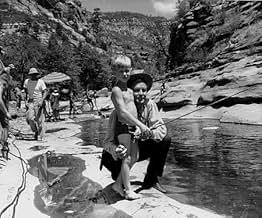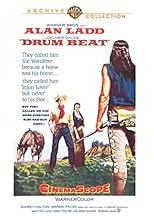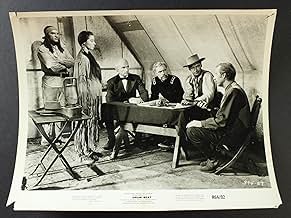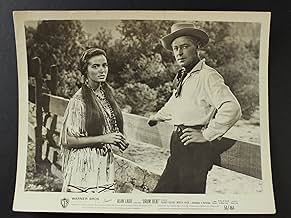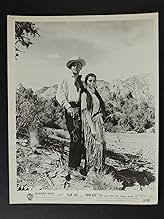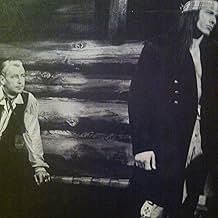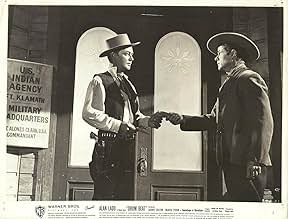Adicionar um enredo no seu idiomaIn 1872, Indian fighter Johnny MacKay is appointed peace commissioner for the California and Oregon territory but he faces tough opposition from the renegade Modocs led by their chief Captai... Ler tudoIn 1872, Indian fighter Johnny MacKay is appointed peace commissioner for the California and Oregon territory but he faces tough opposition from the renegade Modocs led by their chief Captain Jack.In 1872, Indian fighter Johnny MacKay is appointed peace commissioner for the California and Oregon territory but he faces tough opposition from the renegade Modocs led by their chief Captain Jack.
- Direção
- Roteirista
- Artistas
- Modoc Jim
- (as Frank de Kova)
- Capt. Alonzo Clark
- (as George Lewis)
Avaliações em destaque
Also, for this Bronson fan, that jail cell ending may well be the high point of his acting career. He shows more unforced good humor and naturalness there than any scene I've seen him in. In fact, he easily steals the movie from the rest of the cast, positioning himself as a real Hollywood comer.
This is an A-production from Warner Bros. For example, scope out the well stocked cavalry troop. No corner-cutting there. Then too, lavish use is made of Sedona's familiar red rock locations adding real scenic value. Also, there's a much larger than usual supporting cast of familiar faces, even down to bit parts. Producers Daves and Ladd (uncredited) do a bang-up job assembling the many components.
Surprisingly, for plot developments, the Indians actually get to win a battle and rejoice on- screen. However, the film's impact is damaged by being over-long, probably to accommodate a romantic interest to broaden audience appeal. Then too, Ladd, the actor, appears not nearly as interested in the film as Ladd, the co-producer. Frankly, he looks glum throughout the nearly two-hour running time, and I don't think it's from under-playing the part. Plus having him over-power the muscular, extremely fit looking Bronson is quite a stretch.
Despite these several drawbacks, it's still a good scenic, action flick, the first of director Daves' series of superior Westerns.
However, credit director Delmer Daves for finding some gorgeous locations for his story and casting Charles Bronson and Anthony Caruso as Indians who look marvelously authentic in their make-up. Not so fortunate are Marisa Pavan and Audrey Dalton in the weak female roles that could have been played by any young ingénue on the Warner lot.
Alan Ladd is the Indian expert hired by President Grant to make peaceful overtures to the Modocs, headed by Bronson. Elisha Cook, Jr. is interesting as a corrupt Indian trader and most of the supporting roles get good results, especially in the action scenes, all of which are well-staged by director Daves. Especially good is a climactic fight between Ladd and Bronson as they tumble down a rushing stream and fall over the rocky terrain. Ladd seems to be doing most of his stunts in this action-packed scene.
But otherwise, he delivers a rather stoic performance, showing barely any expression even in his brief love scenes with Audrey Dalton. Hard to tell if he was bored or just impatient with the routine script.
All in all, worth watching for the action scenes and the handsome landscapes filmed in beautiful WideScreen Technicolor.
The history may be real but it's told from one side of the conflict. This is an old fashion western in more than one way. It definitely has the scenery. Most white folks starting with MacKay are simply trying to keep the peace. The Indians are the trouble makers along with some white settlers. It's an early role for Bronson and he does some fine red-face acting. Alan Ladd is doing very blend acting. It's probably deliberate to give this character the persona of a peace giver. It may be propaganda but it works for the audience of its day. The American government only wants to help the red savage and some just refuse to be civilized.
For the first time an American general was killed during the wars against the Indian tribes. The little known Modoc war was another of those lesser known conflicts as action against the Sioux on the Great Plains and the Apache in the Arizona desert got far more attention.
The Modocs were moved from a reservation in northern California to one in Oregon to share with the Klamath, a tribe that had a long feuding history with the Modoc. That was the immediate cause of the war. It was kept going by one of the Modoc's more charismatic leaders, a chief named Captain Jack.
On April 11, 1873, General E.R.S. Canby among other peace commissioners who were sitting in council with Captain Jack and the other chiefs were suddenly shot and killed, in fact Captain Jack personally did shoot General Canby. Charles Bronson in his very first film with that name having dropped his real birth last name of Buckinsky plays Captain Jack. Warner Anderson plays the feckless and luckless Canby.
The horror of that incident aroused some bad public opinion against the Modocs, not to dissimilar against to what was aroused against the Japanese after Pearl Harbor and Islamist extremists after the World Trade Center attack albeit on a much smaller scale. It certainly shifted priorities for a while in the War Department from the Sioux and the Apache.
Alan Ladd plays a real frontier figure named Johnny MacKay who as the film has him was a civilian scout employed by the army to find Captain Jack. His role in real life was not at the center stage of the film, but he did play a part in the Modoc Wars. And he was not among the surviving peace commissioners he wasn't at the meeting when the assassinations happened.
For all its inaccuracies Drum Beat is the only film I know to deal with this incident that shocked a nation during The Gilded Age.
Canby's Cross is a monument erected on the site of the killings, to honor the men lost. On the cross, is inscribed, "Gen Canby USA was murdered here by the Modocs April 11, 1873"
The real Canby was shot in the face. In the movie, it appeared they kept that detail, as you see him clutch his face after the second shot.
Você sabia?
- CuriosidadesActor Charles Buchinsky (his birth name) changed his name to Charles Bronson, using his new moniker for the first time in this film, and remained so for the rest of his acting career.
- Erros de gravaçãoPresident Grant is shown wearing his Army uniform in the White House. This is inaccurate as General Grant resigned his commission in 1869.
- Citações
Dr. Thomas: Don't you feel like a murderer?
Johnny MacKay: No, sir.
Dr. Thomas: Shouldn't you?
Johnny MacKay: I've never shot anyone without cause. My job is to protect the wagon train. When somebody shoots at my people, I shoot back.
- ConexõesFeatured in The Good Life (2007)
Principais escolhas
- How long is Drum Beat?Fornecido pela Alexa
Detalhes
Bilheteria
- Orçamento
- US$ 1.100.000 (estimativa)
- Tempo de duração
- 1 h 51 min(111 min)
- Proporção
- 2.55 : 1

